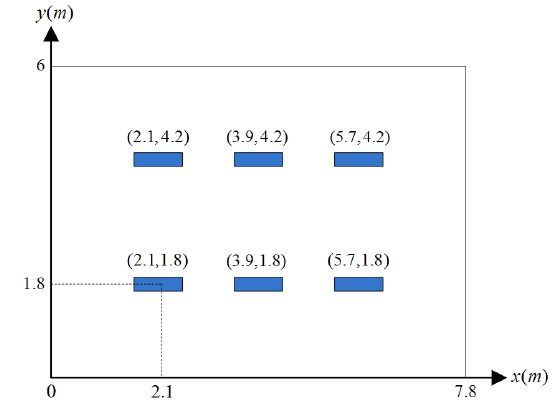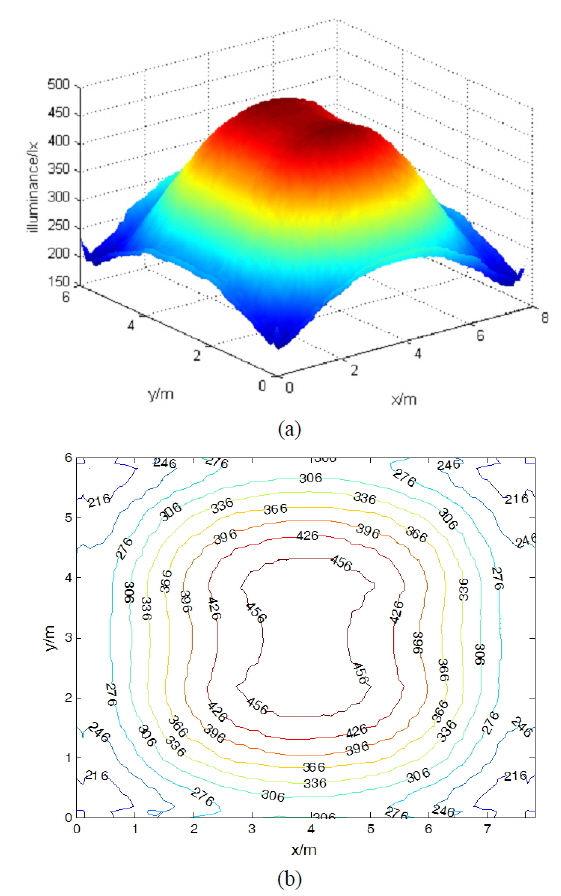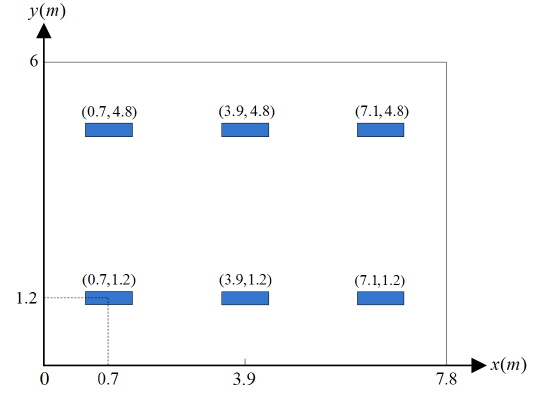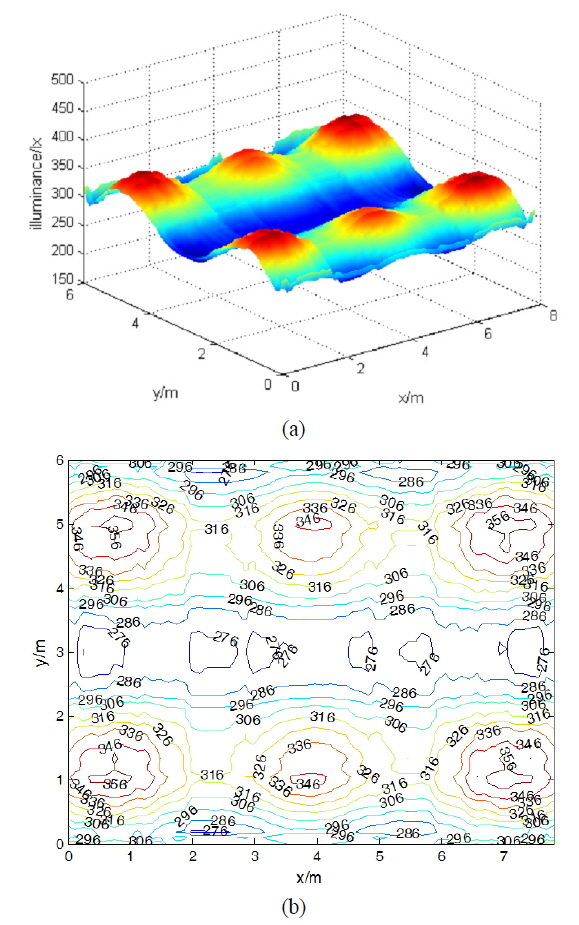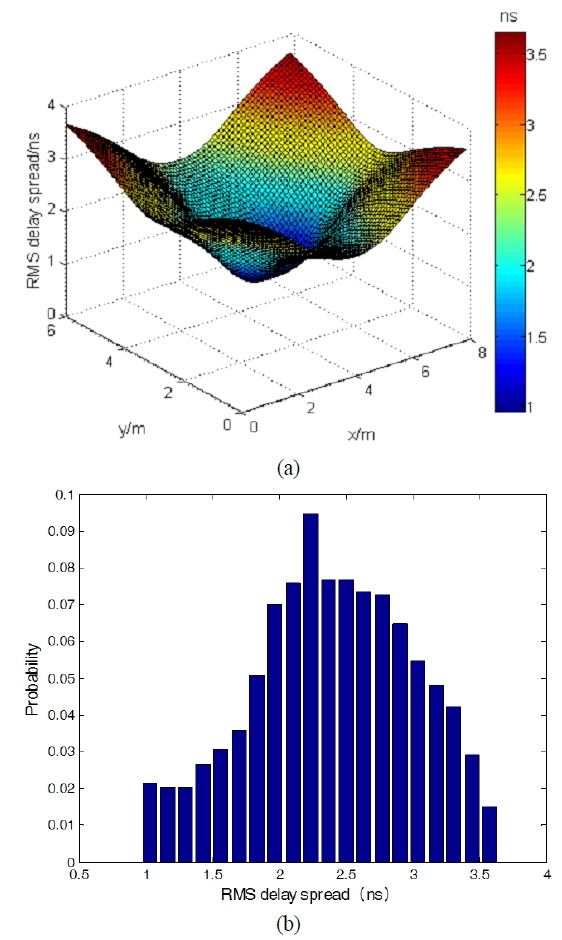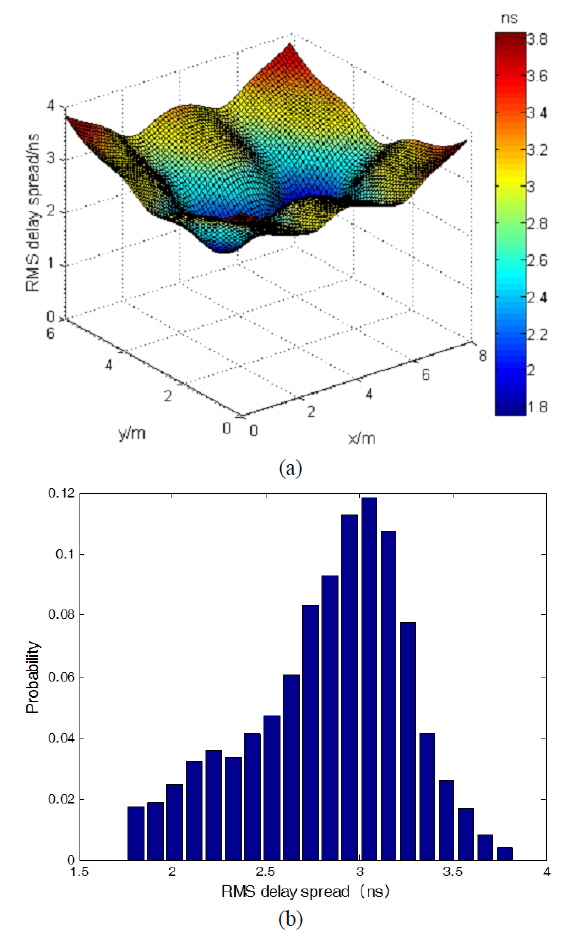



Since white LEDs (light-emitting diodes) were invented in the1990’s, they have been extensively researched [1, 2]. Compared with the previous lighting devices, the white LED is more advantageous in terms of high brightness, lower power consumption, smaller size, longer lifetime, and environmental protection [3-5]. Because of these advantages, the white LED is considered as a strong candidate for the future lighting technology and will replace most of the conventional light sources in offices and homes [6-8]. Generally speaking, the LED lamps are not only used as a lighting device, but also to be used as a communication device [9]. The dual function of the LED lamps has aroused a lot of research interests in recent years. The lamp arrangement is one of the most critical issues in indoor VLC systems. It is known that a single LED lamp can’t provide sufficient illumination, so we tend to install several LED lamps on the ceiling to illuminate the room as evenly as possible. A lot of research has been done in the field [10-12]. And the research has shown that different LED lamp arrangements will have different illumination and communication quality, that is, both the lighting effects and the communication quality are closely related to the arrangement of the LED lamps [10, 13, 14]. Actually, in the same room, with the same number of the lamps, there is always an optimal arrangement, which can make full use of the LED lamps and gain the best uniformity. For the sake of simplicity, the word ‘lamp’ refers to ‘LED lamp’ in the rest of the paper.
The lamps can be, in principle, arbitrarily distributed, however, it is convenient to distribute regularly on the ceiling, for the purpose of uniform illumination. Most attention has been paid to the arrangement of 2 × 2. In the literature [4], for example, Toshihiko Komine et al. proposed a room model 5 × 5 × 3 m3, in which the size of the ceiling is 5.0 m × 5.0 m. This room model is called the square room model, since the plane where the lamps locate is square. Similarly, if the ceiling of a room is a rectangle, we called it a rectangular room model. In the proposed square room model, a method of determining the location of the lamps is to divide the ceiling plane into 2 × 2 parts and put one lamp in the center of each part. This method of determining the location of the lamps is easy, but not accurate or optimal. What we pursue is a method that can help to find the optimal arrangement accurately for any room model, such as the square room model, rectangular room model and so on. What’s more, when determining the locations of the LED lamps, the effect of reflection is always neglected, which make the results not so accurate for a real scenario. Actually, in a real scenario, the reflection is always there. According to literature [4], the ratio of the first order of reflection is 4.84 percent, which will exert influence on the arrangement of the lamps. So, in order to gain the optimal arrangement accurately, the first order reflection is taken into consideration when determining the location of the lamps. And in the calculation, the Multi-Input Multi-Output (MIMO) system model is applied to reduce the amount of calculations.
In addition, the previous research has been mainly based on the square room model, as far as we know, no study of the rectangular room model is available. However, in the real environment, the rectangular room model is more common, so we choose a rectangular office room scenario for our study, in which 2 × 3 lamps distribute on the ceiling symmetrically. The real scenario is illustrated schematically in Fig. 1. Since the most important and common target illumination function in daily life is still uniform distribution around the room. Hence, in this paper, we focus on the uniform illumination distribution by the 2 × 3 lamps, with other environmental parameters unchanged.
To get the best uniformity, we propose a method to calculate the optimal location of the lamps and to gain the optimal arrangement, in which the first order reflection is taken into consideration. In literature [14], the received optical power is used to analyze the optimal arrangement. Since the distribution of illumination has the same shape as that of the received optical power when the FOV is 90 degrees, so the optimal arrangement would be the same no matter whether illumination or received optical power is used to analyze the lamp arrangement. In this paper, we focus on analyzing the optimal arrangement from illumination. Under the optimal arrangement, a better illumination distribution is achieved, which proves the validity of the method. Meanwhile, when the lamps work as a communication device, the optical signals of the lamps travel via different paths and arrive at the receivers at different intervals in time. The optical path difference between the multiple sources triggers inter-signal-interference (ISI), which will significantly degrade the performance of the indoor VLC system [1, 9]. To judge the influence of the optimal arrangement on the communication quality, the root mean square (RMS) delay spread is studied, which is a better measurement for the spread of multipath and can predict ISI accurately [1, 15]. Simulation results indicate that the fluctuation of the RMS can be mitigated by the optimal arrangement, comparing with the original lamp arrangement.
The rest of this paper is organized as follows: in Section Two, the principle parameters of LED, the real office room scenario and illumination distribution are presented. In Section Three, the method to gain the optimal arrangement is introduced and the optimal arrangement of the office room is presented. Section Four shows the simulation results under the optimal arrangement, including the illumination distribution and the RMS delay spread distribution. Finally, Section Five presents the conclusion.
II. PRINCIPLE PARAMETERS AND OFFICE ROOM SCENARIO
LED has two basic properties, a luminous intensity and a transmitted optical power. The relationship between photometric and radiometric quantities is explained in [16, 17]. In this paper, the Lambertian radiation pattern is applied to model the LED radiant irradiance [14].
Where,
The luminous intensity in angle
A horizontal illumination
Where,
The consideration for illumination of LED lighting is required. Generally, illuminance of lights is standardized by the International Organization for Standardization (ISO). According to this set of standards, illuminance of 300 to 1500 lx is required for office work [4].
2.2. The Office Room Scenario and Illumination Distribution
In this subsection, the room scenario we choose and the illumination distribution under the original arrangement is introduced. The size of the office room is 7.8×6×3 m3. The lamps are installed at the height of 3.0 m from the floor. The height of the desk is 0.8 m, and the receiver is put on the desk. The number of the lamps is six. Each lamp has a total luminous flux of 3600 lm, and the transmitted optical power 36 W. These represent the measured and calculated values of the commercial product PAK310612 PAK-A02-118-DZ. It has a size of 0.625 m × 0.121 m × 0.08 m. The ceiling, wall, and floor have reflective index values of 0.2, 0.8, and 0.7, respectively. The conditions are summarized in Table 1.
[TABLE 1.] Parameters of system configuration
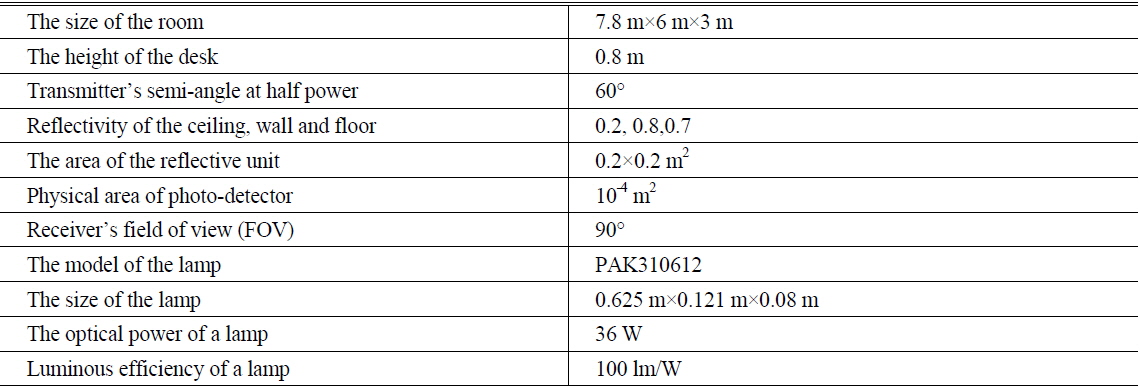
Parameters of system configuration
Here, we define the
In the original arrangement, the six lamps mainly concentrate in the central areas of the room, which will result in larger illumination in the central areas and smaller illumination in the areas close to the walls. The great fluctuation will limit the system’s ability to provide equal lighting effects for the users in any place in the office. Here, uniformity
Where,
The distribution of horizontal illumination under the original arrangement is shown in Fig. 2, where the minimum and the maximum are 186 lx and 475 lx, respectively. And the
The poor illumination distribution in Fig. 2 is caused by the unreasonable arrangement of the lamps: the six lamps are mainly concentrated in a small region of the center. The distance between the lamp source and the receivers in the central regions is much shorter than the receivers in the corners. According to equation (3), the intensity in the central areas is definitely much higher than that in other places, which, finally, lead to the un-uniformity of the illumination. So we try to rearrange the location of the lamps.
III. THE THEORY OF THE OPTIMAL LMAP ARRANGEMENT
In this part, we will introduce the theory of optimal lamp arrangement taking the first order reflection into consideration. Note that in this paper, all the lamps point vertically to the plane where the receiver is located. And the lamp is assumed to be a point source when calculating the optimal lamp arrangement.
In the receiving plane, the total illumination
Here,
Where,
Here,
To calculate the illumination from reflection, we make the following assumptions: to model the reflection from a differential reflecting unit with area
Since the reflective surfaces do not offer perfect reflection, and illumination is inversely proportional to the distance that light travels, a finite unit number of reflective units is considered in calculating the illumination from the reflective planes. And in our discussion, we assume the internal surface is made up of n neighboring units of equal area. Generally speaking, the smaller the area of the reflecting unit, the more accurate the simulation result is. However, the numerous units would increase the run time. Sometimes it can be several days or years. Reducing the number of the units would shorten the run time at the expense of reduced accuracy. So a modest number of reflective units would be better. For a room with a size of
Where,
Here,
Here,
Since reflective units
Where,
And the transfer function
Here,
Where,
Different arrangements will lead to different illumination distributions. To evaluate whether the arrangement is good, here, we introduce the variance of the illumination intensity. When the value of the variance reaches the minimum, the illumination distribution will be the most uniform one. Then we regard the arrangement as optimal. The variance is defined as follows.
Here,
Where,
A computer program is written to implement the algorithm described above. Since the location of the lamp is symmetric with respect to the center of the ceiling. To keep the symmetry, we fix two of the lamps on the ceiling with their abscissa both at 3.9 m, as shown in Fig. 3. So assuming the location of the first lamp is (
4.1. The Distribution of Horizontal Illumination
In this subsection, the distribution of horizontal illumination under the optimal lamp arrangement gained in Section Three will be discussed. To ensure that the results are consistent with the practical situation, the reflection of the walls, the ceiling and the floor are considered. The reflective factor is listed in Table 1. To compare with the illumination distribution under the original arrangement, the environment of the room, the total number of lamps and power of each lamp remains the same.
Figure 4 shows the illumination distribution under the optimal arrangement. The illumination ranges from 266 lx to 363 lx. It can be seen that the maximum illumination doesn’t occur in the center of the room, but occurs in the areas under each lamp. It is because the lamps are not concentrated in a smaller range of the room any more, but are closer to the walls. With the distance between the lamps and the receivers reduced, the receivers close to the walls can receive more light, which helps to mitigate the fluctuation of the illumination. Table 2 shows the comparison in illumination distribution between the original arrangement and the optimal arrangement, it can be seen that compared with the original arrangement, the uniformity
[TABLE 2.] The comparisons between the two lamp arrangements

The comparisons between the two lamp arrangements
4.2. The Performance of RMS Delay Spread
Uniformly-distributed illumination is very important when the lamps work as lighting devices. The RMS delay spread is also desired when considering the communication function. In the indoor VLC system, the signal transmitting path is directly relevant to the transmitters, that is, the locations of the lamps. When the lamps transmit the same signals synchronously, the receiver on the desk receives the signals from different lamps. Since the transmitting path is different, the time at which the signals arrive is different. The path delay of the same signal will lead to ISI, which is sure to deteriorate the quality of communication. A useful measure of the severe ISI induced by a multipath channel is the root mean RMS delay spread
Where,
Where,
Figure 5 shows the distribution of RMS delay spread under the original arrangement, where the RMS delay spread of visible light varies between 0.96 ns and 3.64 ns. The worst RMS delay spread occurs at the edge of the room, and the least RMS delay spread occurs in the center of the room. It means that when a user moves from a place in the center to another in the corners of the room, the quality of the communication quality will decline sharply. That is unfair for the user not in the central places of the office. To measure the fluctuation of
Where, max
In Fig. 5, the maximum RMS delay spread is about 2.7 times higher than the minimum. And the value of the Q is only 0.4, which means a great fluctuation of the RMS delay spread. The fluctuation will limit the system’s ability to provide equal communication quality to multi-users in different places. The poor performance of RMS results from the unreasonable lamp arrangement. Generally, a reasonable arrangement can mitigate the fluctuation. Figure 6 shows the RMS delay spread under the optimal arrangement. We can see the fluctuation is not so obvious and the value of the Q increased from 0.4 to 0.62, increased by 55 percent. As shown in Fig. 6 (b), the probability of the smaller RMS delay spread is much higher than that in Fig. 5 (b).
Though the fluctuation can be mitigated under the optimal lamp arrangement, we must note that there is still a big difference between the maximum and the minimum and the average RMS delay spread increases from 2.39 ns to 2.83 ns, which will not be beneficial to the improvement of the communication quality. It is because in the real scenario, the lamp is not a point light source, but has a certain size, as shown in Fig. 1, while when calculating the optimal locations, the lamps are considered as point light sources for the sake of simplicity. In addition, in this paper, our studies mainly focus on the fairness in providing equal lighting effects and communication quality for the users in any place of the room. So, the
In this paper, we have investigated and studied the LED lamp arrangement, and analyzed the illumination distribution by using a rectangular room model, in which there are 2×3 lamps distributed symmetrically in the ceiling plane. In the analysis, we applied the MIMO system model in our work and proposed a method to determine the location of the lamp taking the first order reflection into consideration, and finally, we gained the optimal arrangement. Under the optimal arrangement, the illumination and RMS delay spread distribution were analyzed. The simulation results show that compared with the original arrangement, the uniformity of the illumination can be improved from 0.55 to 0.86, which ensures almost equal lighting effects for all users at different locations in the room. Meanwhile, the dramatic change of RMS delay spread that incurred by the unreasonable lamp arrangement is mitigated by the optimal lamp arrangement from 0.4 to 0.62.
